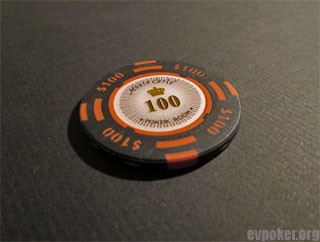Good bankroll management in poker
 Bankroll management (money management is also used, although the signification can be slightly different) is about how to handle your bankroll. It’s not obvious how this shall be done in a solid way. Among poker players bankroll and bankroll management is sometimes called in short BK and BRM.
Bankroll management (money management is also used, although the signification can be slightly different) is about how to handle your bankroll. It’s not obvious how this shall be done in a solid way. Among poker players bankroll and bankroll management is sometimes called in short BK and BRM.
To put some money into a poker account and play until the money is lost and then do it all over again, that’s easy. It’s when you begin to win that things get more complicated. Bankroll management is not only how you handle your bankroll on a macro level, but it’s also how you deal with your money during a playing session.
Recommended bankroll and limits
On a macro level, bankroll management could be about how much money you should bring to the table and eventually how you should set up limits for this money.
So what is an accurate sum to play for and how can you know on what limit you belong? These questions are nearly connected with every person’s economical circumstance in primary. Playing for money that you really can’t afford to lose is a bad idea in many ways. Besides the possible damage to the private economy, your game will probably suffer – in poker language this is called to play with scared money.
It must be an acceptance of a possible loss for the amount you choose to invest in a poker session.
The question about what is a reasonable limit to start on is also depending on your skill. When you start playing poker about money, you could be a complete beginner or you could have played before without real money. In both cases, the lowest limit should be the place to start. Even if you have lots of success playing with your friends, it’s wise to adjust to the mechanisms that involve playing with money by start on low stakes. The only exception for this is if the limits are so futile that you become almost indifferent to the outcome of the game. If this is the case, you should move on to a limit where you can feel motivated to play your best game.
Here are some recommedations in different game formats:
- No Limit hold'em – 20 buy-ins
- Fixed Limit hold'em – 10 buy-ins
- Omaha Pot Limit – 25 buy-ins
- Omaha Hi/Lo Pot Limit – 15 buy-ins
- Omaha Hi/Lo Fixed Limit – 10 buy-ins
- Multi-table tournaments – 30 buy-ins
- Sit & Gos – 25 buy-ins
- Heads-up SNGs – 20 buy-ins
What it does means in bankroll sizes depends on the buy-in level you are on.
Some examples:
- 50NL Hold'em - $1,000 bankroll minimum
- 20PL Omaha - $450 bankroll minimum
- $10 MTT - $300 bankroll minimum
- $10 SNG - $250 bankroll minimum
The buy-in amount
It’s time to return to the question: "What is an accurate sum of money to take to a poker table?" A suitable sum in this case is decided by many factors such as the game variant and your playing style. It’s also a difference between limit and no limit. Commonly, we talk about the amounts of big blinds (BB) a player should have in chips and the recommendation is that you should at least have 80 big blinds on the table in a no limit game and at least 50 big blinds in a limit game.
For example, on a No Limit $0,05/$0,10 table, you should bring at least $8 to the table.
A serious player doesn’t want to be forced to make a new deposit only because of a bad session and lost all or most of the money he had on the table. Your bankroll should, therefore, be bigger than the amount you have on the table when you play. This is, however, something that doesn’t get really important until you go from one limit to a higher.
Move up a limit
If things are working out well for you, you should probably be thinking about to move up to a higher limit. At this stage, good money management is important. The rule number one is: don’t move up to fast.
You should have a solid base (i.e. a bankroll) before you decide to try the next limit. The recommendations here are to have at least 10 times the amount that you bring to the table for a session. When it comes to tournament play an amount of 20-30 buy-ins are enough. If you, for example, play sit n go on a level with $10 buy-in, you should have collected around $300-$500 before you move up to $20 buy-ins.
Move down a level
Sooner or later you will experience a losing streak that cuts badly in your bankroll. At this stage, it’s important to be smart enough and once again understand the significance of good money management. When the bankroll no longer fulfills the criteria for playing on a certain limit, the only right thing is to return to the lower limit until enough money has been won again.
It’s critical to avoid playing under pressure and to have an attitude that always originates in long-term prospects. If you have a close friend that also play poker, it could perhaps be a good idea to play with a joint bankroll, a combined bankroll can bring some new possibilities for both of you.
Related articles:
